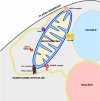Membrane contact sites, gateways for lipid homeostasis
- PMID: 25569848
- PMCID: PMC4380522
- DOI: 10.1016/j.ceb.2014.12.004
Membrane contact sites, gateways for lipid homeostasis
Abstract
Maintaining the proper lipid composition of cellular membranes is critical for numerous cellular processes but mechanisms of membrane lipid homeostasis are not well understood. There is growing evidence that membrane contact sites (MCSs), regions where two organelles come in close proximity to one another, play major roles in the regulation of intracellular lipid composition and distribution. MCSs are thought to mediate the exchange of lipids and signals between organelles. In this review, we discuss how lipid exchange occurs at MCSs and evidence for roles of MCSs in regulating lipid synthesis and degradation. We also discuss how networks of organelles connected by MCSs may modulate cellular lipid homeostasis and help determine organelle lipid composition.
Published by Elsevier Ltd.
Figures



References
Publication types
MeSH terms
Grants and funding
LinkOut - more resources
Full Text Sources
Other Literature Sources

